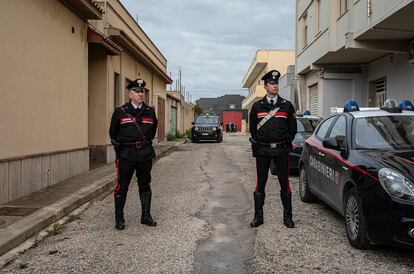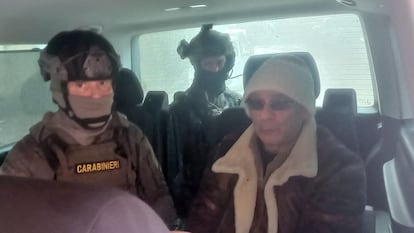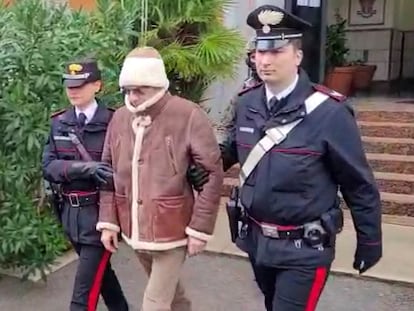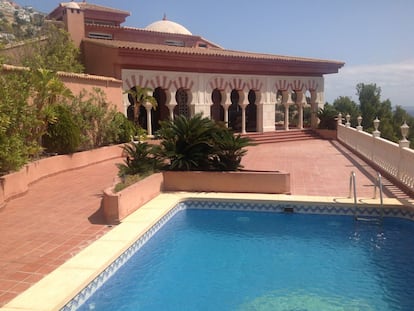Matteo Messina: The fall of Italy’s most-wanted mafia boss
The mobster, who had been on the run for 30 years, was arrested just six miles from the Sicilian town where he was born and raised

Just catching a glimpse of the face of Matteo Messina Denaro would have been a feat, so his arrest on Monday is considered a historic success. Indeed, when the most-wanted mafia boss was captured in Palermo, no one even really knew what he looked like – police had been relying on sporadically updated computer portraits. In the end, it was an old, fragile-looking man who was detained by heavily armed police. People applauded as he was led away, as if cheering the banishment of an evil ogre who had been ravaging the region.
Messina, who had been on the run from authorities for 30 years, had been hiding out just six miles from Castelvetrano, the Sicilian town where he was born and raised. According to the Carabinieri, the national gendarmerie of Italy, and the Palermo prosecutor’s office, he had been living in an apartment in a yellow, two-storey building in Campobello di Mazara. His building was located on a quiet, dead-end street, and many of his neighbors were unaware of his bloody past. “Why would I have suspected anything? He was a well-mannered person who greeted me in the morning,” a local, who lived in the same building, told EL PAÍS. The cashier at the supermarket on the corner also had no idea. “He is very old. How was I going to recognize him?” they said. For his neighbors, it is difficult to identify the frail man with the Costa Nostra boss accused of killing 50 people, including children and pregnant women.
Messina’s arrest marks an end to an era. The bloodiest chapter in the history of Cosa Nostra is over. The last great boss of the Corleone family has fallen.
The Corleonesi mafia clan, originally from the town of Corleone, overtook the Sicilian mafia in the 1980s. They murdered the entire old guard of the Palermo mafia families, who were more bourgeois than the Corleonesi. The mafia’s chiefs, Totò Riina and Bernardo Provenzano, were ruthless. In their thirst for power, they killed judges, police officers, journalists, politicians and hundreds of rival mobsters and their families. They even took on the Italian state in the 1990s, believing that Italy’s ruling party, the Christian Democracy, had broken its unholy alliance with organized crime. Anti-mafia judges Giovanni Falcone and Paolo Borsellino upturned the game, bringing members of Cosa Nostra to face justice for the first time. More than 475 mobsters were arrested thanks to the magistrates, who paid for their actions with their lives. The judges were killed in 1992, the same year the mafia was considering blowing up the Leaning Tower of Pisa. A year later, the mafia set off a bomb outside the Uffizi Gallery in Florence and detonated others in churches in Rome. From that moment on, the Corleonesi mafia’s days were numbered.
From that criminal group, only Messina Denaro was still free as of Monday, and keeping alive the legend of those terrifying years. He was also the last one with the alleged power to blackmail the state with its unspeakable secrets. Riina was captured in 1993, and his successor, Provenzano, was arrested in 2006. It’s not known who will take over now, nor who is really controlling Cosa Nostra, which is divided into various factions. Normally, such power vacuums are filled quickly, but authorities don’t know of any high-profile figures with enough power to take over the entire organization. Instead, they have identified local mafia bosses, who don’t want the trouble that comes with leading the group. It may be that the godfather model, with one leader at the top of a pyramidal organization, is over. After the arrest of Riina and his most dangerous men (Bagarella, Brusca, the Graviano brothers), the Sicilian mafia entered a new phase, focused on slipping under the public’s radar. There were no more massacres or shootouts: the priority was business. That continues to be the case. Today, the ‘Ndrangheta from Calabria is the most feared and powerful mafia in Italy.

Messina Denaro carries more than just symbolic importance: he is also the last custodian of the secrets of the Corleonesi mafia clan. He was Riina’s most faithful ally and idealized the mobster. When Riina was arrested, he was the one who went to his house to remove any incriminating papers – it took 18 days for police to search the property, during which time the surveillance cameras at the residence were mysteriously turned off. It’s one of many disturbing examples of police oversight from this period. The arrest of Messina Denaro opens a new chapter, one that is likely to keep Italy’s courts and the press busy for the next few years. Rather than solve the mysteries of Italy’s recent history, it is likely to raise more questions. Was someone protecting Messina Denaro all these years? In the numerous attempts to capture him, he always evaded authorities at the last moment. How did he manage this? What does he know about the relationship between the Corleonesi mafia and the upper echelons of the state? Did he negotiate an agreement? In the past years, hundreds of people belonging to his economic and protection network have been arrested, including family members. Dozens of companies have also been seized. But up until Monday, Messina Denaro was able to evade capture.
The Carabinieri and Palermo’s assistant prosecutor, Paolo Guido, spent Monday night searching his apartment in Campobello di Mazara to obtain more information about the mobster’s life and the network that helped to hide him for 30 years. No weapons were found inside the home. Messina Denaro spent Monday night in a cell at a secret location in Sicily. After his arrest, he was taken to Boccadifalco military airport. From there, he boarded a helicopter and was taken to a bunker, where he will remain until the end of the first phase of the investigation, which is focused on dismantling his network of collaborators. Messina Denaro’s multimillion-dollar businesses and fortune – estimated at $15 million – is also under investigation.
Part of Messina Denaro’s legend comes from the fact that he was a very unusual mafia boss. He is not from Corleone, but from Castelvetrano, in the west of Siciliy, and he was much younger than other members of the Corleonesi mafia clan. He went into hiding with his father, local mafia boss, Don Ciccio. And when his father died, he left his corpse in the field, perfectly dressed for the funeral. Every year, he put out an obituary in the local newspaper Il Giornale de Sicilia to mark the anniversary of his father’s passing.
Unlike the older, more austere mafia bosses, Messina Denaro liked to have fun. He went out dancing, drove big cars, played video games and had several romances. He never set foot in jail. What’s more, he was an atheist, which was unusual for the mafia, given its interest in saints and virgins. In the end, he was brought down by his poor health. Like many other older mafia bosses, he had to come out of hiding to seek treatment for an undisclosed medical condition. He always had eye problems – he underwent surgery in 1994 at a famous clinic in Barcelona, which is why he wears sunglasses. Personal writings from the mafia boss reveal his nihilistic side and megalomania. All eyes will be watching to see what he is really like when he appears in public for the first time after 30 years on the run.
Sign up for our weekly newsletter to get more English-language news coverage from EL PAÍS USA Edition
Tu suscripción se está usando en otro dispositivo
¿Quieres añadir otro usuario a tu suscripción?
Si continúas leyendo en este dispositivo, no se podrá leer en el otro.
FlechaTu suscripción se está usando en otro dispositivo y solo puedes acceder a EL PAÍS desde un dispositivo a la vez.
Si quieres compartir tu cuenta, cambia tu suscripción a la modalidad Premium, así podrás añadir otro usuario. Cada uno accederá con su propia cuenta de email, lo que os permitirá personalizar vuestra experiencia en EL PAÍS.
¿Tienes una suscripción de empresa? Accede aquí para contratar más cuentas.
En el caso de no saber quién está usando tu cuenta, te recomendamos cambiar tu contraseña aquí.
Si decides continuar compartiendo tu cuenta, este mensaje se mostrará en tu dispositivo y en el de la otra persona que está usando tu cuenta de forma indefinida, afectando a tu experiencia de lectura. Puedes consultar aquí los términos y condiciones de la suscripción digital.
More information
Archived In
Últimas noticias
The new victims of the Republican war on Obamacare: Millions hit by soaring health insurance premiums
A country divided on migrant rights: Some US states expand protections while others restrict them
Venezuela authorizes the release of another 87 political prisoners
There is as much life left to discover on planet Earth as that which is already known
Most viewed
- David King, chemist: ‘There are scientists studying how to cool the planet; nobody should stop these experiments from happening’
- Reinhard Genzel, Nobel laureate in physics: ‘One-minute videos will never give you the truth’
- Oona Chaplin: ‘I told James Cameron that I was living in a treehouse and starting a permaculture project with a friend’
- Sinaloa Cartel war is taking its toll on Los Chapitos
- The Interoceanic Train, the Mexican alternative to the Panama Canal











































